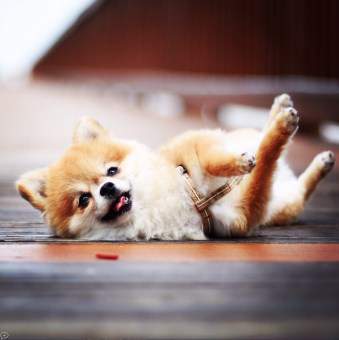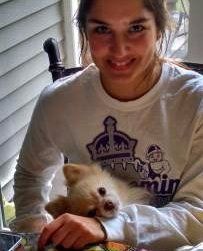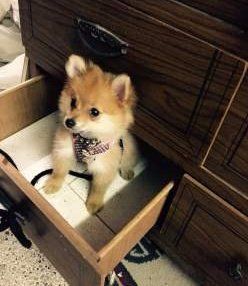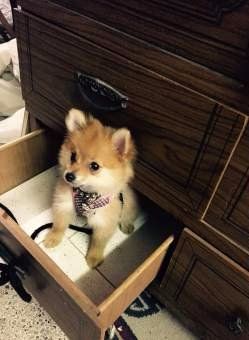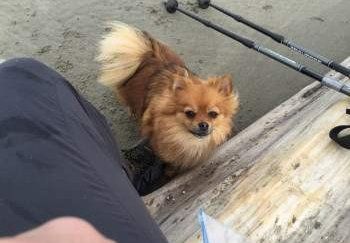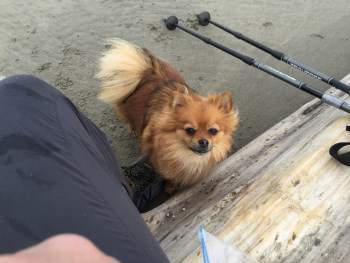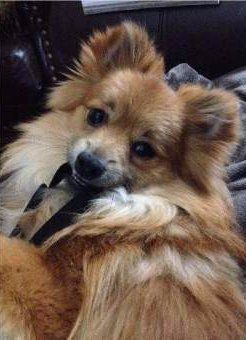Creating a Close Bond with Your Pomeranian
Overview
Of course, you love your Pom and he or she certainly loves you back; however, you may feel that there could be a better bond and a closer relationship… and perhaps a bit more cuddling and more shows of affection.
Your Pom might seem perfectly happy ignoring you most of the time, and maybe doesn't even like to play with you. You may be wondering how to help turn your Pomeranian into a lap dog, which this breed, in general, is referred to as.
In some cases, a Pomeranian may appear to be so independent, that owners worry their dog doesn't even like them.
Issues with seemingly weak bonding, where a Pomeranian doesn't play, snuggle, or give owners very much attention can be seen both with young puppies, and with older dogs. Though, the reasons for this lack of interest or acting distant are different, depending on the Pom's age.
Bonding is not always a natural process. In some cases, it needs to be nurtured and cultivated. And for many Pomeranians, there needs to be regular interaction that not only holds together the relationship that you have established, but also works to increase the bond.
If this issue is ignored, very little may change.
Dogs that do not play or cuddle up, often do not suddenly start engaging their owners first. Cues must come from their humans.
However this is good news, since it means you can take purposeful steps to grow the relationship. And, this section will cover how to do this.
Please note:
PetPom is reader-supported, and some of the product suggestions on this page are affiliate links. As an Amazon Associate we earn from qualifying purchases. This is at no extra cost to you and helps us continue providing free, high-quality information.
Signs of Weak Bonding
The following are signs that there can be come improvement in regard to the bond that you have with your Pomeranian.
The more that you can agree to, the more effort and work that will need to go into improving the relationship.
Do keep in mind, that if there is not a strong bond, this is not a personal reflection of either your or your dog…
Even loving owners may find that somehow important bonding rituals were not done often enough or there were extenuating circumstances that prevented spending enough time together.
- Little or no desire to play
- Little or no eye contact
- Not wanting to cuddle or be petted
- Doesn't want to sit on the owner's lap
- Attempts to run off when being picked up
- Not listening to commands
- Aggression such as baring the teeth or growling
How Much Bonding to Expect
Pomeranians are both shy and sensitive, and
funny and outgoing. They do have an independent streak, which often manifests as having no qualms about letting you know what they like and do not like, but may also follow you around like a shadow.
Essentially, Poms have a range of personalities, so there is no such thing as a Pom acting 'perfect'.
And, canines in general are capable of a range of emotions.
Science has proven that canines have many of the same brain structures that we do, that are responsible for emotion.
And it has been determined that dogs have the emotional development of a 2.5 year old human child. Well, if you have been around a toddler, you know that this is quite something. Dogs will feel sad, happy, excited, jealous
and feel strong affection which has been equated to feeling love. And when dogs love
their human, unless there is neglect or trauma, this love is for life. In healthy environments, dogs do not ever 'break up' with an owner or become angry enough to call it quits; this just doesn't happen in the canine world.
So, once there is a good bond in place, your Pom should be happy to play by himself (you do want this, it makes life easier), but also thoroughly enjoy spending time with you.
Uninterested Puppies
If you have a very young Pomeranian puppy that does not seem interested in your or essentially ignores you, it's important to not take this personally.
Puppies can have a hard time focusing on any one thing…and it takes time for a puppy to realize just who you are and what an important role you play in his life.
Young pups live for the moment. And cognitive abilities are not fully in place. From 8 to 12 weeks old, puppies are just starting to learn social awareness. At 16 weeks, a puppy's brain is at 80% of its full development.
These early months are a prime time for a pup to learn how to become attached to an owner, and learn how to properly interact. It is a process.
If you follow all of the upcoming advice for bonding, the attachment that your puppy will have with you will grow over time.
Issues that May Masquerade as Emotional Distance
1. Health issues
- Many of the signs of what we would classify as a dog not caring or not wanting to be close, may actually be a symptom of a health issue.
Any time that a dog is feeling discomfort or pain, he may retreat and want to be alone. Why? When a canine is ill or injured, he feels vulnerable - even with loving owners - and instinct tells him to retreat and keep his distance.
So, if your Pom has suddenly started acting odd and keeping away or is a puppy and despite the steps listed here, just does not respond, this is a reason to have him or her be brought for a full veterinary examination.
2. Fear
- When a dog is afraid, this can really alter his personality. A Pomeranian that is scared may cower on his bed, try to hide under the bed, or look for a safe spot in a closet. He may be wary of coming close, may shake and/or have trouble eating.
This may be an acute issue such as a dog getting startled by lightening or a loud noise, or it can be caused by an ongoing situation that is keeping the Pomeranian fearful.
If a Pomeranian is living in a state of fear, this can certainly cause the dog to not want to play or interact, and some dogs can be so afraid on a constant basis that it affects everything from eating to sleeping.
3. Stress
- A common reason for stress is separation anxiety; some Poms get so nervous and upset that it is difficult to 'go back to normal' even after an owner arrives back home.
4. Chaotic household
- Pomeranians, or any other dogs for that reason, just cannot act normal and have a close bond with their owner if they are living in a stressful environment and experiencing problems on a constant basis.
This includes music or TVs being blasted, lots of people coming and leaving from the house, frequent yelling, too many pets running about, young children being loud and/or roughhousing, or any other elements that strip away a sense of peace and security. This can keep a dog in a state of high alert, and certainly not relaxed enough to sit on your lap and cuddle.
5. Mistaken play antics
- Another element that can be mistaken for a bonding problem is actually play, believe it or not. We recently corresponded with an owner who was troubled that her Pomeranian would only come to her halfway and then would lie down, seemingly act afraid, staring at her, but refusing to come any closer.
In response, she would pick up the Pom and once settled on the sofa with her, her dog was happy, content and loving. Why would her dog do this? It was determined that her Pomeranian was actually playing a game and was essentially 'trained' to act this way. He would lie down and act as he did, knowing that the next step 'should be' that the owner came over and scooped him up.
How to Create a Bond with Your Pomeranian
There is not one magic remedy for close bonding and turn your Pomeranian into a lap dog. Rather, it is a matter of many things all working together that combine to create a great friendship and one of respect.
1) Establish yourself as the leader.
If you want to bond with your Pomeranian, you probably are thinking that you want your dog to be your best friend… and this can happen, but respect must be there first.
We must remember that the canine to human relationship is different than human to human bonds.
Canines without structure… without a real leader… without the safety of a true 'pack' and clear hierarchy are often confused, may try to take over as leader themselves, and will certainly not have the right foundation to listen or properly interact.
Keep in mind that teaching proper hierarchy cannot be achieved in one day, and owners should follow these rules at all times. Once a Pom learns this, you'll want to continually reinforce this.
In addition, every human in the house should also follow these guidelines, since problem can arise if only one or some humans do this and others ignore this.
The best methods to establish yourself as leader are:
*
Only place down food after the 'sit' command is obeyed. Since we can grab food basically any time we wish, it may be easy to forget that for a dog, his food source = life.
Dogs quickly learn to have respect for owners who make it very clear that they are the reason the food is being placed down. Never tease a dog with food
or make a big deal about it, however expecting a Pomeranian to sit on command for each meal and snack is good way to build a respectful relationship.
*
While you may need to stretch your arm out to do this, it is also very helpful to be the one to enter and exit the house first. When a dog is allowed to charge ahead first, this can be interpreted as being in charge. In the canine world, the leader exits and enters first.
*
Expect your Pom to heel when walking. Far too many owners simply accept the situation of the dog walking ahead; people may joke that it is a case of a dog walking the owners; but, this is in fact how a dog will see things.
Someone needs to lead and be in charge of the walking pace and the destination, and that should be you, not your Pom. Use a harness on your Pomeranian, keep the leash short, and with your dog to your immediate left.
2) Teach your Pom an agility exercise.
While this breed can do well with short bars for jumping or pole weaving, tunnel running is typically the easiest and one of the most fun agility activities your dog could do.
A great tunnel like the HDP Dog Agility Training Open Tunnel
 can be set up outdoors or indoors (if you have a long enough hallway).
can be set up outdoors or indoors (if you have a long enough hallway).
3) Train your Pomeranian for a new command or trick.
When a dog and an owner are working hard toward a goal, this itself is a great bonding experience, regardless of how long it takes. As long as you have tons of enthusiasm and your Pom enjoys this time due to being rewarded for trying hard, that is all that matters.
And of course, a great added benefit is that your Pom will be a well-trained dog. Whether you aim for a simple 'Down' or a more complicated 'Spin', this is a great method to feel that you've achieved something together.
4) Have your Pom help you with household chores.
When we are rushing around cleaning and trying to get things done in the house, it's easy to place our Pom in his area and go about our chores; however this is a huge missed opportunity to bond. Slow down the pace a bit and allow your Pomeranian to be your assistant.
One of the best chores to take on together is sorting clean laundry. We've found that teaching a Pom to give us socks or small wash clothes, gives him a job that he can be proud of. It takes a while to teach a dog which items to mouth and 'hand over'; however with consistent practice this can be accomplished.
After a while, a Pom will get very excited that it is 'laundry time' and will rush over to help. Be sure to always end with a super tasty reward
for the good work.
5) Bring your Pom with you as often as you can.
There are several things that prevent an owner from bringing their Pomeranian along with them to run errands and whatnot.
First, some owners worry that if they spend too much time together, this will increase the dog's separation anxiety as he will be 'too used' to being with the owner.
However, having a full and happy life outside of those times of being home alone can only increase a dog's overall happiness.
The second issue is that owners may just want to rush out to get things done as quickly as possible, rationalizing that they will just leave their Pom home since they will be back soon.
However this is also a huge missed opportunity to bond. Whether you dashing off to grab milk at the corner store or need to explore a hardware store for just the right item, bring your Pom when at all possible.
The last issue that gets in the way are the logistics of this, which includes a Pom having trouble in the car such as motion sickness or the limitations of physically carrying a Pom while out and about.
But, there remedies for this:
1. If your Pom has trouble in the car, using the right car seat
and help quite a bit.
2. If you're unsure of how to physically bring your Pom along, placing a Pomeranian in a carry sling like the i'Pet Hands-free Small Dog Carrier Sling
 can be a great option.
can be a great option.
6) Engage your Pom in play.
If your Pomeranian doesn't want to play with you, chances are that with some small adjustments, the level of enthusiasm will increase. Here are some tips:
1.
Choose an area without distractions.
2.
Keep it simple. When you are first trying to get your Pom to play with you, it's too much to also expect a puppy or dog to learn a complicated game such as puzzles, or those that depend on commands. So, the classic came of fetch often works well.
3.
Use the right toss toy. You'll want it to be properly sized; if the toy is not easily mouthed and carried, Poms can become discouraged.
Some good choices include Zanies Mini Tennis Balls , which are perfectly sized and very colorful.
, which are perfectly sized and very colorful.
Another really good one is the Kong Wubba Toy ; this is a super fun toss toy that has two types of balls (one a small tennis ball, and one is a squeaker ball) that is wrapped in fabric, and has trailing tails that flutter when it's thrown.
; this is a super fun toss toy that has two types of balls (one a small tennis ball, and one is a squeaker ball) that is wrapped in fabric, and has trailing tails that flutter when it's thrown.
The tails are also easy for a Pom to mouth, and can make carrying the toy quite easy.
4.
Be enthusiastic, even if your Pom is not. Don't feel defeated and go into this assuming that your Pomeranian doesn't like you. Have the attitude that with some practice, things will get better. If you are happy, speak in a cheerful tone, and have fun just trying, your Pom will pick up on this.
Remember, you cannot trick a canine; their senses are amazing and your dog will know if you're faking.
7) Take on a new challenge together.
This can be anything that you enjoy or think that you would enjoy.
This may include getting your Pom a life vest like the Vivaglory Dog Life Vest in Extra Small , dabbing sunscreen on his nose and taking him out on a canoe… or waking up early to finally go see that sunrise over the ocean… or choosing an 'easy' hiking trail that will lead you both to new sights and sounds. It does not matter what it is, as long as you choose something new to do with your Pom.
, dabbing sunscreen on his nose and taking him out on a canoe… or waking up early to finally go see that sunrise over the ocean… or choosing an 'easy' hiking trail that will lead you both to new sights and sounds. It does not matter what it is, as long as you choose something new to do with your Pom.
Owners that are single often hesitate to explore like this because they don't have someone to do it with; but when you have a dog, you are never alone.
You May Also Like:
Pomeranian is Acting Lethargic
- Top causes of this, including health issues. Remedies for a dog feeling a bit down in the dumps.
Removing Tear Stains from a Pomeranian
- If there is discolored fur under or around the eyes, this is often staining. You'll want to address the triggers, and use the right product to remove these.
Best Food for a Pomeranian
- There are lots of things to avoid, and nutritional requirements you'll want to be meeting.



